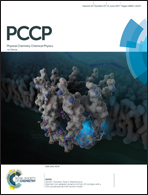Reactions between hydroxyl-substituted alkylperoxy radicals and Criegee intermediates: correlations of the electronic characteristics of methyl substituents and the reactivity†
Abstract
The reactions of four hydroxyl-substituted alkylperoxy (RO2) radicals with four stabilized Criegee intermediates (SCIs) were investigated. Due to the existence of various reactive sites in both RO2 and SCI, various reaction modes were obtained. By adjusting the relative orientation of the two components of the reactants, different pathways were predicted. The addition of RO2 radical terminal oxygen atom to SCI carbonyl carbon is a favorable reaction mode. For RO2 radicals, increasing the number of methyl substituents in β-carbon will promote the addition reaction. Carbonyl oxides with hydrogen atoms as substituents in the anti-position react faster than the corresponding carbonyl oxides with hydrogen atom substituents in the syn-position. Thus, the reaction barrier can be “tuned” by the substitution of alkyl groups. The analysis of the transition states have revealed that there were correlations between the reaction barrier heights, NPA charges and electron spin population of the terminal oxygen of RO2, as well as between the interatomic distances of O–C in transition states. As the oligomers formed by the sequential addition of SCIs to RO2 radicals are the common components of secondary organic aerosols, the investigation was able to contribute to understand the formation of SOA.



 Please wait while we load your content...
Please wait while we load your content...